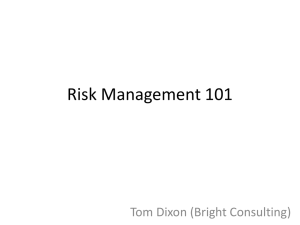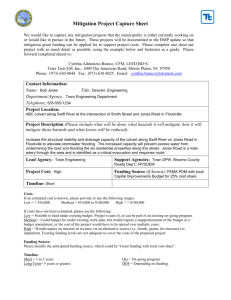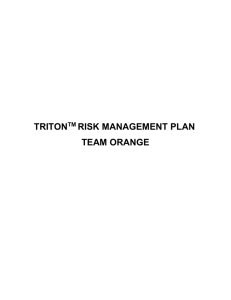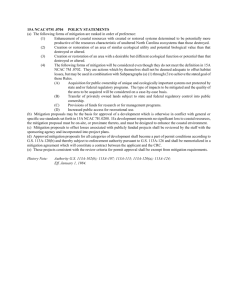PROCESS 306 EVALUATE RISK. DEVELOP MITIGATION
advertisement
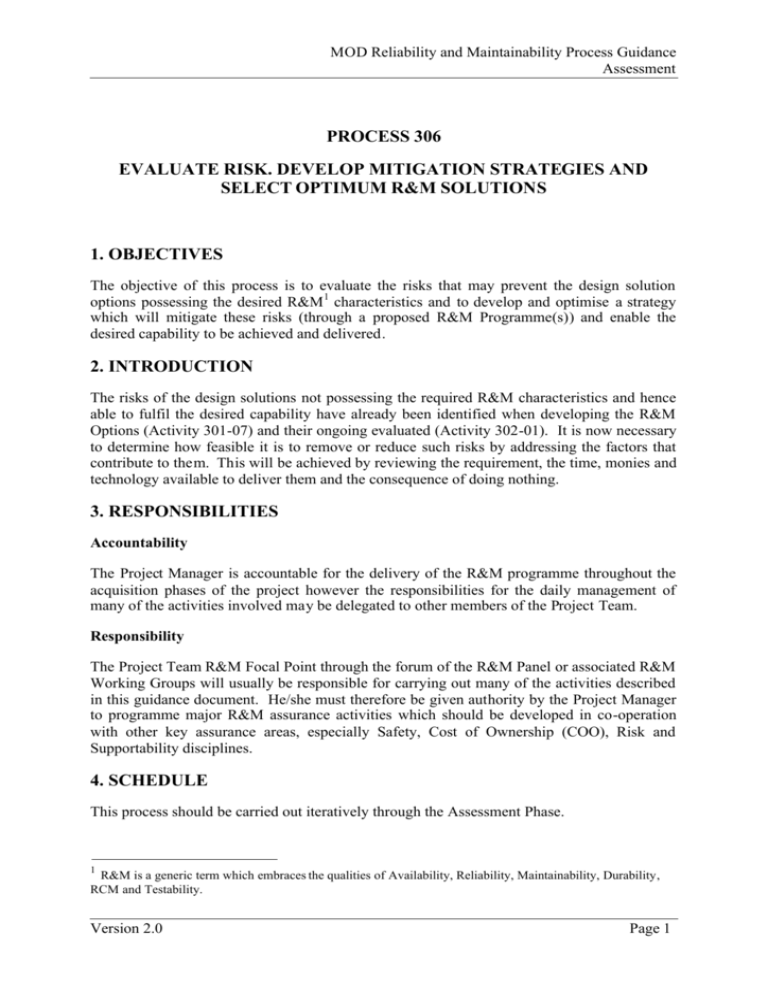
MOD Reliability and Maintainability Process Guidance Assessment PROCESS 306 EVALUATE RISK. DEVELOP MITIGATION STRATEGIES AND SELECT OPTIMUM R&M SOLUTIONS 1. OBJECTIVES The objective of this process is to evaluate the risks that may prevent the design solution options possessing the desired R&M1 characteristics and to develop and optimise a strategy which will mitigate these risks (through a proposed R&M Programme(s)) and enable the desired capability to be achieved and delivered. 2. INTRODUCTION The risks of the design solutions not possessing the required R&M characteristics and hence able to fulfil the desired capability have already been identified when developing the R&M Options (Activity 301-07) and their ongoing evaluated (Activity 302-01). It is now necessary to determine how feasible it is to remove or reduce such risks by addressing the factors that contribute to them. This will be achieved by reviewing the requirement, the time, monies and technology available to deliver them and the consequence of doing nothing. 3. RESPONSIBILITIES Accountability The Project Manager is accountable for the delivery of the R&M programme throughout the acquisition phases of the project however the responsibilities for the daily management of many of the activities involved may be delegated to other members of the Project Team. Responsibility The Project Team R&M Focal Point through the forum of the R&M Panel or associated R&M Working Groups will usually be responsible for carrying out many of the activities described in this guidance document. He/she must therefore be given authority by the Project Manager to programme major R&M assurance activities which should be developed in co-operation with other key assurance areas, especially Safety, Cost of Ownership (COO), Risk and Supportability disciplines. 4. SCHEDULE This process should be carried out iteratively through the Assessment Phase. 1 R&M is a generic term which embraces the qualities of Availability, Reliability, Maintainability, Durability, RCM and Testability. Version 2.0 Page 1 Process 306 Evaluate Risk, Develop Mitigation Strategies and Select Optimum R&M Solutions 5. INPUTS The following inputs will be required to carry out this process: R&M Risks previously associated with individual Design Solutions options. 6. OUTPUTS Prioritised list of preferred R&M options to develop and deliver the compliant capability; Outline R&M Programme strategy; Input to the R&M Case in the form of an Evidence Acceptance Framework to support the down selection process and provide traceability. 7. DESCRIPTION OF ACTIVITIES Activity 306-01 – Determine Probability of Removing/Reducing Risk Determine the probability of reducing the R&M risks associated with each solution option. Performance, cost and timescale risks have previously (Activity 305-07) been traded off for the various design solution options, however these design solutions will have a number of their own inherent risks associated with them. It is necessary to determine the probability of removing or reducing these risks. These risks are not only restricted to the top level KURs associated with R&M through statements relating to availability or sustainability but other factors e.g. ability to operate across the environmental profile, to be designed within the size and weight restraints, to integrate with or into other systems, technology insertion etc. The following four activities 306-02 through to 306-05) consider this mitigation further. Activity 306-02 – Determine if Requirement can be Modified to Reduce Risk Determine in association with the stakeholders if any of the risk can be mitigated by modifying the requirement. Changing, or relaxing a requirement to mitigate a risk is probably the quickest, easiest and cheapest of the options considered here, however the implications if not considered fully are probably the greatest. Before changing a requirement the following should be considered: Has the Requirements Analysis (Ao, PSA) been conducted properly? Are requirements fully justified or have they been ‘gold plated’? Is the metric appropriate or would another be more suited? Operational analysis seldom addresses the detailed specification of R&M but expresses itself in terms of capability, other times availability of the solution, and it is the acquisition process that evolves this requirement into that of the URD and future SRD. The sustainability of that capability can be retained by high reliability with little maintenance but conversely by a high maintenance intervention with a solution which is relatively unreliable. While the former Page 2 Version 2.0 MOD Reliability and Maintainability Process Guidance Assessment may be unaffordable initially the latter may be unacceptable through life and compromise is often sort. Where compromise cannot be achieved or the reliability-maintenance burden balanced, risk will exist. Achieving such a balance is far from straightforward particularly when it is constantly being driven by the influence of the projects cost, time and technology restraints, however understanding the detailed capability requirements can often greatly assist. For a given common solution the specific requirements of one user could be vastly different to that of another. A medium utility vehicle may cover more kilometres in a month over harsher terrain in the hands of a front line unit yet, may travel less distance in a year when operated by the more static support arms. Similarly a training establishment my use a system or equipment far greater than a front line unit purely because of the capability while essential may seldom be required for operational use. Therefore it is important to appreciate and understand all the specific users needs and specify appropriately. Where requirements conflict it may be more appropriate and cost effective to compromise and accept the greater maintenance burden for one user while exceeding that of the other. Requirements which are ‘better than last time’ are fraught with risk because they have seldom been thought through even if the specification of that previous purchase was known. In the early phases of the project keep the R&M requirements in the simple terms of duty cycle, conditions and period with any associated maintenance restraint. This will make them easier to be understood and the consequence of change to mitigate risk easier to appreciate. When a requirement is extended or reduced by a given measure, whether it is kilometres, hours, rounds etc. most stakeholders will understand the change relatively quickly. However should such changes be expressed in terms of reliability/probability for many in an audience it will be more difficult to quantify the change in a meaningful measure and care, time and effort needs to be invested to ensure all stakeholders appreciate the consequence of such change. Unfortunately customers and other stakeholders often do not appreciate the acquisition consequence of their requirements. While every practical effort should be taken to satisfy their genuine needs there is nothing to be lost by discussing those requirements, in details with such stakeholders, to ensure that the effort to mitigate the associated risks is warranted and not to satisfy little more than a potential ‘wish list’. Activity 306-03 – Determine if Cost/Time/Technology is Available to Mitigate Risk Determine if risks associated with each solution option can be mitigated within the perceived budget, time and technology constraints. Unfortunately few capabilities can be readily satisfied off the shelf resulting in the majority of projects needing some degree of development, in some instances this will be from scratch on the drawing-board, other times minor modifications to an existing product. Whether a solution needs extensive development or whether on the few occasions it can be acquired directly for use there will always be risk that procuring, developing where necessary and demonstrating compliance of the R&M elements of the solution options cannot be achieved within the cost, time and technology restraints available. When procuring and where necessary developing the solution options if they cannot be achieved within these restraints the risks must be discussed with all the stakeholders and compromised reached. Increasing the available budget or extending the in-service date would provide options for reducing such risks as would alternative options to reducing the performance characteristics of the requirement. Similarly when technology cannot address Version 2.0 Page 3 Process 306 Evaluate Risk, Develop Mitigation Strategies and Select Optimum R&M Solutions the shortfalls the only option may be in conjunction with the stakeholders to reconsider the requirements. Demonstrating compliance performs two functions; first to ensure that what was contracted for has been delivered but equally to ensure that a compliant solution is not falsely rejected. Demonstrating compliance in most instances is both time consuming and expensive therefore while not completing it may alleviate one risk it may well introduce others and hence warrant careful consideration as another risk reduction option. Activity 306-04 – Determine if Solution can be Changed/Modified to Mitigate Risk Determine if the proposed solutions would be tolerant of change and modification to enable the perceived risks to be mitigated. Whether a capability is to be designed from scratch, the integration of a number of proven assemblies or could, in most parts, be satisfied through proprietary Commercial Off The Shelf (COTS) or Military Off The Shelf (MOTS) solutions any shortfall (risk) to develop and demonstrate compliance will require mitigation. Even when finance and time are available it cannot be assumed without question that risk will always be resolved. The COTS or MOTS solution may be so specialised they would not tolerate such modification to reduce risk or the implications of modification would perhaps cost more financially and/or in programme time than an alternative option. Risk mitigation for a given solution option however may not only be restricted for technical reasons, manufacturers may be incapable or unwilling to mitigate risk. The latter being particularly common when the quantity required is small or the supplier already has a sound customer base and adopt a take it or leave it attitude. Other risks however may not relate directly to a manufacturers ability or willingness to develop and manufacture but to the confidence we have in the solution concept. Sound proven technology used in a novel way or the unusual integration of proven technology or systems can each influence risk and create mitigation dilemma. Risk however my not be restricted to the new acquisition, the requirement of a solution to be tolerant of existing systems and/or to integrate legacy systems and equipment, particularly when these systems and equipment’s are vintage, into them can quickly escalate risk. In recent years the requirement for vehicle manufacturers to stay abreast of engine emission regulations and IT manufacturers to retain backwards compatibility with legacy computer systems and networks are examples of solution being challenged to satisfy capabilities. While it may be perceived that these are design integration issues the inability to successfully resolve them are seen inservice as a reliability issue and maintenance burden. Activity 306-05 – Determine Consequence of Doing Nothing Determine in association with the stakeholders the consequence of not mitigating the risk for each proposed solution. Accepting a risk and doing nothing to mitigate it may seem to contradict all that has been advised so far but it remains an alternative which warrants consideration. Even for the most polished requirement and hence solution option there may be times where the resources are just not available, the risk is small or is so dependant on other factors at this time it cannot be perceived to be mitigated. Page 4 Version 2.0 MOD Reliability and Maintainability Process Guidance Assessment That is not to suggest it should not be assessed, in fact if at this time nothing is going to be done about it, it is of the highest priority that it is assessed in depth to ensure the consequence of doing nothing now and potentially in the future are fully appreciated. Such assessment should be conducted with the full co-operation of all interested stakeholders and through the forum of the projects risk management system. The risk and therefore mitigating action must be considered within the context of the operating environment and scenario because accepting the risk may well impose limitations on these parameters. Particularly when this capability is to form an integral part of another equipment or system then the consequences must also be considered towards the host solution of not directly mitigating the risk. However not all risks are solution based some will relate to time or confidence both of which may be beyond the projects resources. One solution may be preferred to another yet the penalty may be development time which the customer would be willing to tolerate to obtain the solution. Alternatively while funds may be available to develop the solution they may not be sufficient to provide the desired confidence through trialling and testing that compliance has been achieved. In both these instances a pragmatic approach is required and as with all risks an informed decision made to optimise the shortfall. Activity 306-06 – Develop Assessment Matrix Develop an assessment matrix and process to enable the selection and prioritisation in respect of R&M of the proposed solutions. The Assessment Matrix needs to be developed in parallel with the risk analysis activities throughout this process to enable the preferred solution in respect of R&M to be selected based on informed knowledge and appreciation of the potential risks and their mitigation. The content of the matrix will be determined by the acquisition strategy and the solution options however it will need to embrace not only the options but the risks involved and the proposed mitigation with the relevant arguments and assumptions supporting them. For each risk it will be necessary to determine the cost, time, technical limitations and any subsequent long term implications to the capability of the subsequent mitigation. Much of this should already form part of the project risk register however in selecting the preferred solution option it is necessary to compare their qualities as well as the full costs of the mitigation to enable an informed decision to be made regarding such comparison. Subject to the form of the project risk register this may be insufficient for the needs of the R&M Focal Point, however, there is much information already written in AOF and other reference text books addressing three or preferred five point estimating methodology. Activity 306-07 – Populate Assessment Matrix Populate the assessment matrix with the evidence, arguments, assumptions, constraints and risks to enable the proposed solutions to be prioritised in respect of their R&M qualities. Subject to the way in which the project is being managed and where responsibilities lay within the project team will depend by whom and how the Assessment Matrix will be populated. Usually it is conducted as a function of the R&M Panel however it is as likely to be delegated to an R&M working group or a sub-committee of the projects risk management committee to which the R&M Focal Point will find themselves having a significant input whichever the forum. The process of populating the matrix is not a one-off activity but should be completed as information becomes available for each option. As information and Version 2.0 Page 5 Process 306 Evaluate Risk, Develop Mitigation Strategies and Select Optimum R&M Solutions supporting evidence and argument changes likewise the matrix needs to be updated to reflect such changes to ensure that the selection process will be made using the most current information, arguments and assumptions available. The majority of projects employ a form based risk management assessment system which will most likely satisfy the requirements for R&M data entry with little or no modification. Whichever method is adopted it needs to be a systematic approach to ensure each solution option is assessed, based on the same criteria and not already biased, during the data entry process. Activity 306-08 – Select Preferred R&M Option With a view of achieving and demonstrating compliance, prioritise the proposed solution from an R&M perspective. A sound, well constructed Assessment Matrix should have the inherent properties to generate a prioritised output of solution options with very little intervention beyond that of data entry. However, which is the preferred R&M solution option and which are the projects preferred solution option seldom co-inside and compromise will be required to select that most suited to best deliver the capability within the project resources. The Project Management Committee needs to be advised through the Chair of the R&M Panel of the prioritised options to satisfy the capability from an R&M perspective with the advantages and disadvantages of each option explained in detail. While one option may be preferred over another, should it be unaffordable, or cannot be contracted for it will not happen. Conversely an option which is less desirable in terms of R&M but which is affordable may with appropriate support satisfy the Customers expectations completely. 8. RECORDS AND DOCUMENTATION A populated R&M Assessment Matrix of R&M Solution Options for inclusion in the R&M Case; A recommendation from the R&M Panel in the form of a prioritised list of R&M Solution Options with associated advantages and disadvantages which if implemented would enable the R&M requirements of the capability to be delivered; An updated R&M Case Report. 9. ADDITIONAL REFERENCE AND GUIDANCE R&M Management Responsibilities and Requirements for Programmes and Plans are set out in Def Stan 00-40 Part 1: http://www.dstan.mod.uk; Guidance on R&M progressive assurance throughout the CADMID cycle is available in Def Stan 00-42, Part 3: http://www.dstan.mod.uk and from the R&M area of the AOF: http://www.aof.mod.uk Guidance is available from the R&M area of the AOF: http://www.aof.mod.uk ; Page 6 Version 2.0 MOD Reliability and Maintainability Process Guidance Assessment General guidance on R&M tools and techniques can be found in: Applied R&M Manual for Defence Systems (GR-77): http://www.sars.org.uk/bok.htm and on the Defence Intranet. Version 2.0 Page 7 Process 306 Evaluate Risk, Develop Mitigation Strategies and Select Optimum R&M Solutions Process 306 - Evaluate Risk, Develop Mitigation Strategies and Select Optimum R&M Solutions Page 8 Version 2.0


